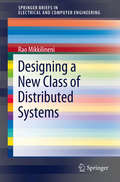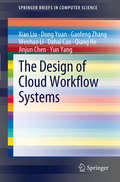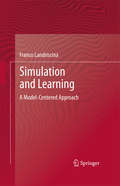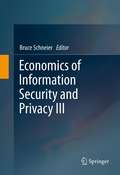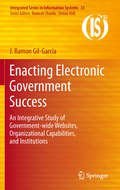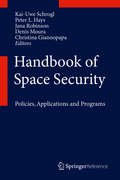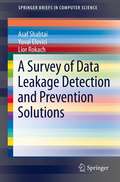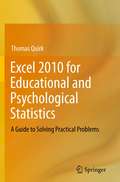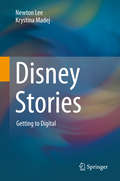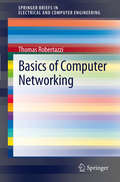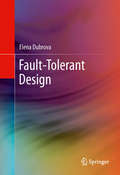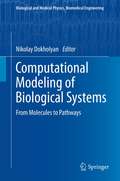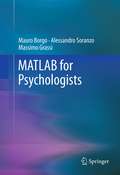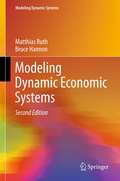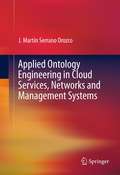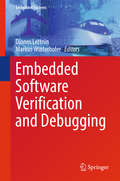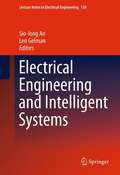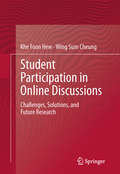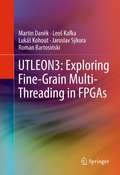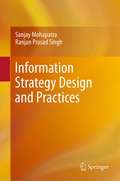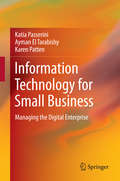- Table View
- List View
Designing a New Class of Distributed Systems
by Rao MikkilineniDesigning a New Class of Distributed Systems closely examines the Distributed Intelligent Managed Element (DIME) Computing Model, a new model for distributed systems, and provides a guide to implementing Distributed Managed Workflows with High Reliability, Availability, Performance and Security. The book also explores the viability of self-optimizing, self-monitoring autonomous DIME-based computing systems. Designing a New Class of Distributed Systems is designed for practitioners as a reference guide for innovative distributed systems design. Researchers working in a related field will also find this book valuable.
The Design of Cloud Workflow Systems
by Qiang He Dahai Cao Dong Yuan Wenhao Li Xiao Liu Yun Yang Gaofeng Zhang Jinjun ChenCloud computing is the latest market-oriented computing paradigm which brings software design and development into a new era characterized by "XaaS", i.e. everything as a service. Cloud workflows, as typical software applications in the cloud, are composed of a set of partially ordered cloud software services to achieve specific goals. However, due to the low QoS (quality of service) nature of the cloud environment, the design of workflow systems in the cloud becomes a challenging issue for the delivery of high quality cloud workflow applications. To address such an issue, this book presents a systematic investigation to the three critical aspects for the design of a cloud workflow system, viz. system architecture, system functionality and quality of service. Specifically, the system architecture for a cloud workflow system is designed based on the general four-layer cloud architecture, viz. application layer, platform layer, unified resources layer and fabric layer. The system functionality for a cloud workflow system is designed based on the general workflow reference model but with significant extensions to accommodate software services in the cloud. The support of QoS is critical for the quality of cloud workflow applications. This book presents a generic framework to facilitate a unified design and development process for software components that deliver lifecycle support for different QoS requirements. While the general QoS requirements for cloud workflow applications can have many dimensions, this book mainly focuses on three of the most important ones, viz. performance, reliability and security. In this book, the architecture, functionality and QoS management of our SwinDeW-C prototype cloud workflow system are demonstrated in detail as a case study to evaluate our generic design for cloud workflow systems. To conclude, this book offers a general overview of cloud workflow systems and provides comprehensive introductions to the design of the system architecture, system functionality and QoS management.
Simulation and Learning
by Franco LandriscinaThe main idea of this book is that to comprehend the instructional potential of simulation and to design effective simulation-based learning environments, one has to consider both what happens inside the computer and inside the students' minds. The framework adopted to do this is model-centered learning, in which simulation is seen as particularly effective when learning requires a restructuring of the individual mental models of the students, as in conceptual change. Mental models are by themeselves simulations, and thus simulation models can extend our biological capacity to carry out simulative reasoning. For this reason, recent approaches in cognitive science like embodied cognition and the extended mind hypothesis are also considered in the book.. A conceptual model called the "epistemic simulation cycle" is proposed as a blueprint for the comprehension of the cognitive activies involved in simulation-based learning and for instructional design.
Simulation and Learning: A Model-Centered Approach
by Franco LandriscinaThe main idea of this book is that to comprehend the instructional potential of simulation and to design effective simulation-based learning environments, one has to consider both what happens inside the computer and inside the students' minds. The framework adopted to do this is model-centered learning, in which simulation is seen as particularly effective when learning requires a restructuring of the individual mental models of the students, as in conceptual change. Mental models are by themeselves simulations, and thus simulation models can extend our biological capacity to carry out simulative reasoning. For this reason, recent approaches in cognitive science like embodied cognition and the extended mind hypothesis are also considered in the book.. A conceptual model called the "epistemic simulation cycle" is proposed as a blueprint for the comprehension of the cognitive activies involved in simulation-based learning and for instructional design.
Economics of Information Security and Privacy III
by Bruce SchneierThe Workshop on the Economics of Information Security (WEIS) is the leading forum for interdisciplinary scholarship on information security, combining expertise from the fields of economics, social science, business, law, policy and computer science. Prior workshops have explored the role of incentives between attackers and defenders, identified market failures dogging Internet security, and assessed investments in cyber-defense. Current contributions build on past efforts using empirical and analytic tools to not only understand threats, but also strengthen security through novel evaluations of available solutions. Economics of Information Security and Privacy III addresses the following questions: how should information risk be modeled given the constraints of rare incidence and high interdependence; how do individuals' and organizations' perceptions of privacy and security color their decision making; how can we move towards a more secure information infrastructure and code base while accounting for the incentives of stakeholders?
Enacting Electronic Government Success
by J. Ramon Gil-GarciaMany countries around the world are investing a great amount of resources in government IT initiatives. However, few of these projects achieve their stated goals and some of them are complete failures. Therefore, understanding e-government success has become very important and urgent in recent years. In order to develop relevant knowledge about this complex phenomenon, researchers and practitioners need to identify and assess what are the main conditions, variables, or factors that have an impact on e-government success. However, before being able to evaluate these impacts, it is necessary to define what e-government success is and what some e-government success measures are. This book presents a review of both e-government success measures and e-government success factors. It also provides empirical evidence from quantitative analysis and two in-depth case studies. Although based on sound theory and rigorous empirical analysis, the book not only significantly contributes to academic knowledge, but also includes some practical recommendations for government officials and public managers. Theoretically, the book proposes a way to quantitatively operationalize Fountain's enactment framework. Based on the institutional tradition, the technology enactment framework attempts to explain the effects of organizational forms and institutional arrangements on the information technology used by government agencies. According to Fountain (1995; 2001) the technology enactment framework pays attention to the relationships among information technology, organizations, embeddedness, and institutions. This framework is very well known in the e-government field, but is normally used for qualitative analysis and there is no previous proposal of how to use it with quantitative data. The book proposes variables to measure each of the different constructs in this framework and also tests the relationships hypothesized by Fountain's theory. Finally, using the advantages of the selected quantitative analysis technique (Partial Least Squares), the study also proposes some adjustments and extensions to the original framework in a theory building effort. Methodologically, the book reports on one of the first multi-method studies in the field of e-government in general and e-government success in particular. This study uses a nested research design, which combines statistical analysis with two in depth case studies. The study begins with a statistical analysis using organizational, institutional, and contextual factors as the independent variables. An overall score representing e-government success in terms of the functionality of state websites is the dependent variable. Second, based on the statistical results two cases are selected based on their relative fitness to the model (residuals) and their position in the general ranking of website functionality (which includes four different measures). In order to complement the results of the statistical analysis, case studies were developed for the two selected states (New York and Indiana), using semi-structured interviews and document analysis. In terms of the statistical analysis, the book constitutes one of the first applications of Partial Least Squares (PLS) to an e-government success study. PLS is a structural equations modeling (SEM) technique and, therefore, allows estimating the measurement model and the structural model simultaneously. The use of this sophisticated statistical strategy helped to test the relationships between e-government success and different factors influencing it, as well as some of the relationships between several of the factors, thus allowing exploring some indirect effects too.
Theory, Analysis and Design of RF Interferometric Sensors
by Seoktae Kim Cam NguyenTheory, Analysis and Design of RF Interferometric Sensors presents the theory, analysis and design of RF interferometric sensors. RF interferometric sensors are attractive for various sensing applications that require every fine resolution and accuracy as well as fast speed. The book also presents two millimeter-wave interferometric sensors realized using RF integrated circuits. The developed millimeter-wave homodyne sensor shows sub-millimeter resolution in the order of 0.05 mm without correction for the non-linear phase response of the sensor's quadrature mixer. The designed millimeter-wave double-channel homodyne sensor provides a resolution of only 0.01 mm, or 1/840th of the operating wavelength, and can inherently suppress the non-linearity of the sensor's quadrature mixer. The experimental results of displacement and velocity measurement are presented as a way to demonstrate the sensing ability of the RF interferometry and to illustrate its many possible applications in sensing. The book is succinct, yet the material is very much self-contained, enabling readers with an undergraduate background in electrical engineering or physics with some experiences or graduate courses in RF circuits to understand easily.
Handbook of Space Security
by Kai-Uwe Schrogl Peter L. Hays Jana Robinson Denis Moura Christina GiannopapaSpace Security involves the use of space (in particular communication, navigation, earth observation, and electronic intelligence satellites) for military and security purposes on earth and also the maintenance of space (in particular the earth orbits) as safe and secure areas for conducting peaceful activities. The two aspects can be summarized as "space for security on earth" and the safeguarding of space for peaceful endeavors. The Handbook will provide a sophisticated, cutting-edge resource on the space security policy portfolio and the associated assets, assisting fellow members of the global space community and other interested policy-making and academic audiences in keeping abreast of the current and future directions of this vital dimension of international space policy. The debate on coordinated space security measures, including relevant 'Transparency and Confidence-Building Measures, ' remains at a relatively early stage of development. The book offers a comprehensive description of the various components of space security and how these challenges are being addressed today. It will also provide a number of recommendations concerning how best to advance this space policy area, given the often competing objectives of the world's major space-faring nations. The critical role to be played by the United States and Europe as an intermediary and "middle diplomat" in promoting sustainable norms of behavior for space will likewise be highlighted. In providing a global and coherent analytical approach to space security today, theHandbook focuses on four areas that together define the entire space security area: policies, technologies, applications, and programs. This structure will assure the overall view of the subject from its political to its technical aspects. Internationally recognized experts in each of the above fields contribute, with their analytical synthesis assured by the section editors. "
A Survey of Data Leakage Detection and Prevention Solutions (SpringerBriefs in Computer Science)
by Yuval Elovici Asaf Shabtai Lior RokachSpringerBriefs present concise summaries of cutting-edge research and practical applications across a wide spectrum of fields. Featuring compact volumes of 50 to 100 pages (approximately 20,000- 40,000 words), the series covers a range of content from professional to academic. Briefs allow authors to present their ideas and readers to absorb them with minimal time investment. As part of Springer's eBook collection, SpringBriefs are published to millions of users worldwide. Information/Data Leakage poses a serious threat to companies and organizations, as the number of leakage incidents and the cost they inflict continues to increase. Whether caused by malicious intent, or an inadvertent mistake, data loss can diminish a company's brand, reduce shareholder value, and damage the company's goodwill and reputation. This book aims to provide a structural and comprehensive overview of the practical solutions and current research in the DLP domain. This is the first comprehensive book that is dedicated entirely to the field of data leakage and covers all important challenges and techniques to mitigate them. Its informative, factual pages will provide researchers, students and practitioners in the industry with a comprehensive, yet concise and convenient reference source to this fascinating field. We have grouped existing solutions into different categories based on a described taxonomy. The presented taxonomy characterizes DLP solutions according to various aspects such as: leakage source, data state, leakage channel, deployment scheme, preventive/detective approaches, and the action upon leakage. In the commercial part we review solutions of the leading DLP market players based on professional research reports and material obtained from the websites of the vendors. In the academic part we cluster the academic work according to the nature of the leakage and protection into various categories. Finally, we describe main data leakage scenarios and present for each scenario the most relevant and applicable solution or approach that will mitigate and reduce the likelihood and/or impact of the leakage scenario.
Excel 2010 for Educational and Psychological Statistics
by Thomas J QuirkExcel has become an important and nearly ubiquitous classroom and office resource for students and practitioners who are faced with solving statistical problems on an everyday basis. Despite this, there has yet to emerge a truly practical, "how-do-I-do-it" manual that teaches the various applications and processes/formulas for Excel in educational and psychological Statistics. Quirk's Excel 2010 for Educational and Psychological Statistics will fill this void, as it is designed to be a step-by-step, exercise-driven guide for education and psychology students who need to master Excel to create formulas and solve statistical problems. Each chapter first explains briefly the formulas that are included in the chapter, and then directs the student on how to use Excel commands and formulas to solve a specific business problem. Three practice problems are provided at the end of each chapter, along with their solutions in an Appendix. At the end of the Excel Guide, an additional Practice Exam allows the reader to test his or her understanding of each chapter by attempting to solve a specific educational or psychometrical issue or problem using Excel (the solution to this problem is also given in an Appendix). From the beginning of the book, readers/students are taught how to write their own formulas and then how to utilize Excel drop-down formula menus as well for such exercises involving one-way ANOVA, simple linear regression, and multiple correlation.
Disney Stories
by Newton Lee Krystina MadejDisney Stories: Getting to Digital explores how Disney, the man and the company, used technological innovation to create characters and stories that engage audiences in many different media, in particular in Video Games and on the Internet. Drawing on Disney films from the twenties and thirties, as well as the writings of historians, screenwriters and producers, Disney Stories: Getting to Digital explains how new film and animation techniques, many developed by Disney, worked together to evolve character and content development and produce entertaining stories that riveted audiences. Through an insider's perspective of Disney's legendary creation process, the book closely examines how the Disney Company moved its stories into the digital world in the 1990s and the virtual, online communities of the 2000s. By embracing the digital era, Disney led storytelling and technological innovation by granting their audience the unique opportunity to take part in their creation process through their online games, including The Lion King Animated Story Book, Disney Blast and Toontown. Disney Stories: Getting to Digital is intended for Disney fans and current practitioners looking to study the creation process of one of the most famous animation studios in existence. Professors teaching courses in new media, animation and interactive storytelling will also find this book a valuable asset.
Basics of Computer Networking (SpringerBriefs in Electrical and Computer Engineering)
by Thomas RobertazziSpringer Brief Basics of Computer Networking provides a non-mathematical introduction to the world of networks. This book covers both technology for wired and wireless networks. Coverage includes transmission media, local area networks, wide area networks, and network security. Written in a very accessible style for the interested layman by the author of a widely used textbook with many years of experience explaining concepts to the beginner.
Fault-Tolerant Design
by Elena DubrovaThis textbook serves as an introduction to fault-tolerance, intended for upper-division undergraduate students, graduate-level students and practicing engineers in need of an overview of the field. Readers will develop skills in modeling and evaluating fault-tolerant architectures in terms of reliability, availability and safety. They will gain a thorough understanding of fault tolerant computers, including both the theory of how to design and evaluate them and the practical knowledge of achieving fault-tolerance in electronic, communication and software systems. Coverage includes fault-tolerance techniques through hardware, software, information and time redundancy. The content is designed to be highly accessible, including numerous examples and exercises. Solutions and powerpoint slides are available for instructors.
Computational Modeling of Biological Systems: From Molecules to Pathways (Biological and Medical Physics, Biomedical Engineering)
by Nikolay V DokholyanComputational modeling is emerging as a powerful new approach to study and manipulate biological systems. Multiple methods have been developed to model, visualize, and rationally alter systems at various length scales, starting from molecular modeling and design at atomic resolution to cellular pathways modeling and analysis. Higher time and length scale processes, such as molecular evolution, have also greatly benefited from new breeds of computational approaches. This book provides an overview of the established computational methods used for modeling biologically and medically relevant systems.
MATLAB for Psychologists
by Alessandro Soranzo Mauro Borgo Massimo GrassiThe matrix laboratory interactive computing environment--MATLAB--has brought creativity to research in diverse disciplines, particularly in designing and programming experiments. More commonly used in mathematics and the sciences, it also lends itself to a variety of applications across the field of psychology. For the novice looking to use it in experimental psychology research, though, becoming familiar with MATLAB can be a daunting task. MATLAB for Psychologists expertly guides readers through the component steps, skills, and operations of the software, with plentiful graphics and examples to match the reader's comfort level. Using an extended illustration, this concise volume explains the program's usefulness at any point in an experiment, without the limits imposed by other types of software. And the authors demonstrate the responsiveness of MATLAB to the individual's research needs, whether the task is programming experiments, creating sensory stimuli, running simulations, or calculating statistics for data analysis. Key features of the coverage: Thinking in a matrix way.Handling and plotting data.Guidelines for improved programming, sound, and imaging.Statistical analysis and signal detection theory indexes.The Graphical User Interface.The Psychophysics Toolbox.MATLAB for Psychologists serves a wide audience of advanced undergraduate and graduate level psychology students, professors, and researchers as well as lab technicians involved in programming psychology experiments.
Modeling Dynamic Economic Systems
by Bruce Hannon Matthias RuthThis book explores the dynamic processes in economic systems, concentrating on the extraction and use of the natural resources required to meet economic needs. Sections cover methods for dynamic modeling in economics, microeconomic models of firms, modeling optimal use of both nonrenewable and renewable resources, and chaos in economic models. This book does not require a substantial background in mathematics or computer science.
Applied Ontology Engineering in Cloud Services, Networks and Management Systems
by J. Martin SerranoMetadata standards in today's ICT sector are proliferating at unprecedented levels, while automated information management systems collect and process exponentially increasing quantities of data. With interoperability and knowledge exchange identified as a core challenge in the sector, this book examines the role ontology engineering can play in providing solutions to the problems of information interoperability and linked data. At the same time as introducing basic concepts of ontology engineering, the book discusses methodological approaches to formal representation of data and information models, thus facilitating information interoperability between heterogeneous, complex and distributed communication systems. In doing so, the text advocates the advantages of using ontology engineering in telecommunications systems. In addition, it offers a wealth of guidance and best-practice techniques for instances in which ontology engineering is applied in cloud services, computer networks and management systems. Engineering and computer science professionals (infrastructure architects, software developers, service designers, infrastructure operators, engineers, etc.) are today confronted as never before with the challenge of convergence in software solutions and technology. This book will help them respond creatively to what is sure to be a period of rapid development.
Embedded Software Verification and Debugging
by Djones Lettnin Markus WinterholerThis book provides comprehensive coverage of verification and debugging techniques for embedded software, which is frequently used in safety critical applications (e. g. , automotive), where failures are unacceptable. Since the verification of complex systems needs to encompass the verification of both hardware and embedded software modules, this book focuses on verification and debugging approaches for embedded software with hardware dependencies. Coverage includes the entire flow of design, verification and debugging of embedded software and all key approaches to debugging, dynamic, static, and hybrid verification. This book discusses the current, industrial embedded software verification flow, as well as emerging trends with focus on formal and hybrid verification and debugging approaches.
Analog Circuit Design for Process Variation-Resilient Systems-on-a-Chip
by Marvin Onabajo Jose Silva-MartinezThis book describes several techniques to address variation-related design challenges for analog blocks in mixed-signal systems-on-chip. The methods presented are results from recent research works involving receiver front-end circuits, baseband filter linearization, and data conversion. These circuit-level techniques are described, with their relationships to emerging system-level calibration approaches, to tune the performances of analog circuits with digital assistance or control. Coverage also includes a strategy to utilize on-chip temperature sensors to measure the signal power and linearity characteristics of analog/RF circuits, as demonstrated by test chip measurements. Describes a variety of variation-tolerant analog circuit design examples, including from RF front-ends, high-performance ADCs and baseband filters;Includes built-in testing techniques, linked to current industrial trends;Balances digitally-assisted performance tuning with analog performance tuning and mismatch reduction approaches;Describes theoretical concepts as well as experimental results for test chips designed with variation-aware techniques.
Electrical Engineering and Intelligent Systems
by Sio-Iong Ao Len GelmanThe revised and extended papers collected in this volume represent the cutting-edge of research at the nexus of electrical engineering and intelligent systems. They were selected from well over 1000 papers submitted to the high-profile international World Congress on Engineering held in London in July 2011. The chapters cover material across the full spectrum of work in the field, including computational intelligence, control engineering, network management, and wireless networks. Readers will also find substantive papers on signal processing, Internet computing, high performance computing, and industrial applications. The Electrical Engineering and Intelligent Systems conference, as part of the 2011 World Congress on Engineering was organized under the auspices of the non-profit International Association of Engineers (IAENG). With more than 30 nations represented on the conference committees alone, the Congress features the best and brightest scientific minds from a multitude of disciplines related to engineering. These peer-reviewed papers demonstrate the huge strides currently being taken in this rapidly developing field and reflect the excitement of those at the frontiers of this research.
Student Participation in Online Discussions
by Khe Foon Hew Wing Sum CheungThe increasingly prevalent use of online- or blended-learning in schools universities has resulted in asynchronous online discussion forum becoming an increasingly common means to facilitate dialogue between instructors and students, as well as students and students beyond the boundaries of their physical classrooms. This proposed academic book contributes to the literature on asynchronous online discussions in the following three main ways: First, it reviews previous research studies in order to identify the factors leading to limited student contribution. Limited student contribution is defined as students making few or no postings, students exhibiting surface-level thinking or students demonstrating low-level knowledge construction in online discussions. It then identifies the various empirically-based guidelines to address the factors. Second, three potential guideline dilemmas that educators may encounter: (a) use of grades, (b) use of number of posting guideline, and (c) instructor-facilitation are introduced. These are guidelines where previous empirical research shows mixed results when they are implemented. Acknowledging the dilemmas is essential for educators and researchers to make informed decisions about the discussion guidelines they are considering implementing. Third, nine exploratory case studies related to student-facilitation and audio-based discussion are reported on and examined. Using students as facilitators may be an alternative solution to educators who wish to avoid the instructor-facilitation guideline dilemma. Using audio discussion would be useful for participants with poor typing skills or those who prefer talking to typing. The proposed book is distinctive in comparison to current competitor titles because all the findings and guidelines are empirically-based. Furthermore, the nine expanded case studies provided specifically address the issue of student/peer facilitation and audio-based discussion. Student/peer facilitation and audio discussion are two areas that hitherto received comparatively lesser attention compared to instructor facilitation and text-based discussion.
UTLEON3: Exploring Fine-Grain Multi-Threading in FPGAs
by Martin Daněk Lukáš Kohout Jaroslav Sýkora Roman Bartosiński Leoš KafkaThis book describes a specification, microarchitecture, VHDL implementation and evaluation of a SPARC v8 CPU with fine-grain multi-threading, called micro-threading. The CPU, named UTLEON3, is an alternative platform for exploring CPU multi-threading that is compatible with the industry-standard GRLIB package. The processor microarchitecture was designed to map in an efficient way the data-flow scheme on a classical von Neumann pipelined processing used in common processors, while retaining full binary compatibility with existing legacy programs.
Information Strategy Design and Practices
by Ranjan Prasad Singh Sanjay MohapatraInformation Strategy Design and Practices develops a framework for designing information technology strategy for an organization. Beyond this, it establishes an approach to not only implement it, but sustain it. The framework explains how IT strategy should have an alignment to business to reap the benefits of business. The book contains five case studies in different domains: retail, real estate development, IT product development, development sector, and education sector. These case studies have been applied to different countries, providing a global prospective to this emerging trend.
Variational Analysis and Aerospace Engineering: Mathematical Challenges for Aerospace Design
by Giuseppe Buttazzo Aldo FredianiThis volume consists of papers presented at the Variational Analysis and Aerospace Engineering Workshop II held in Erice, Italy in September 2010 at the International School of Mathematics "Guido Stampacchia". The workshop provided a platform for aerospace engineers and mathematicians (from universities, research centers and industry) to discuss the advanced problems requiring an extensive application of mathematics. The presentations were dedicated to the most advanced subjects in engineering and, in particular to computational fluid dynamics methods, introduction of new materials, optimization in aerodynamics, structural optimization, space missions, flight mechanics, control theory and optimization, variational methods and applications, etc. This book will capture the interest of researchers from both academia and industry.
Information Technology for Small Business
by Ayman El Tarabishy Karen Patten Katia PasseriniInformation Technology for Small Business: Managing the Digital Enterprise provides an overview of how small and medium business enterprises (SMEs) can use flexibility, agility, and anticipation strategies to better utilize information technology and knowledge management. Because small and medium businesses tend to be late technology adopters, they could miss versatile and strategic workforce advantages that enable them to achieve higher efficiency and effectiveness through technology. This book shows these SMEs new technology trends that can transform the nature of their operations both in an evolutionary business path and through revolutionary opportunities. Information Technology for Small Business: Managing the Digital Enterprise applied correctly to small and medium business can be used as a strategic tool to reach growth and profit goals for the SMEs competing in a very dynamic and global marketplace. Examples include: identifying ways that IT can be used to develop strong relationships with customers and suppliers, and how to select the best technologies for business needs. Information Technology for Small Business: Managing the Digital Enterprise targets SME owners, educators, and practitioners working in the related fields of management, IT, IS, and CS-related disciplines. Advanced-level students and policy makers focusing on SMEs will also find this book valuable in terms of main concepts for discussion.
